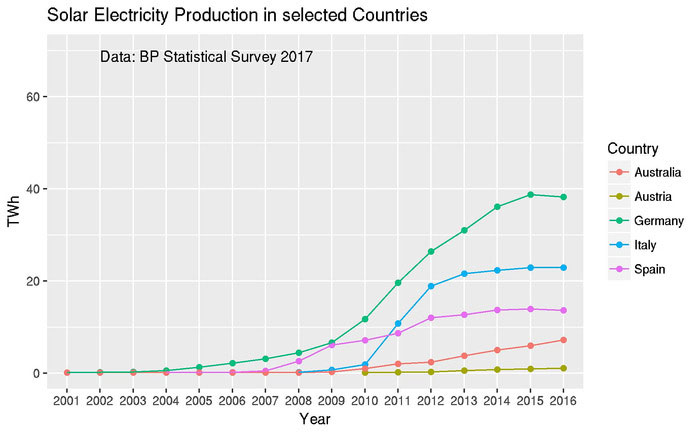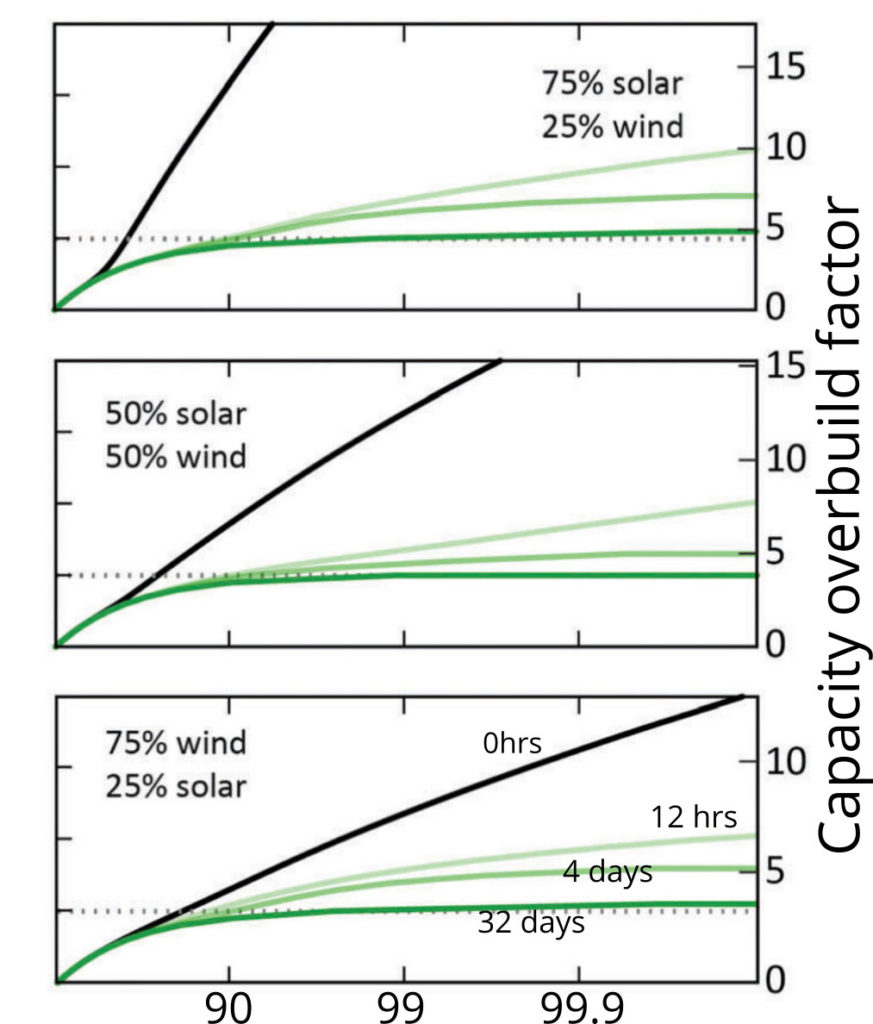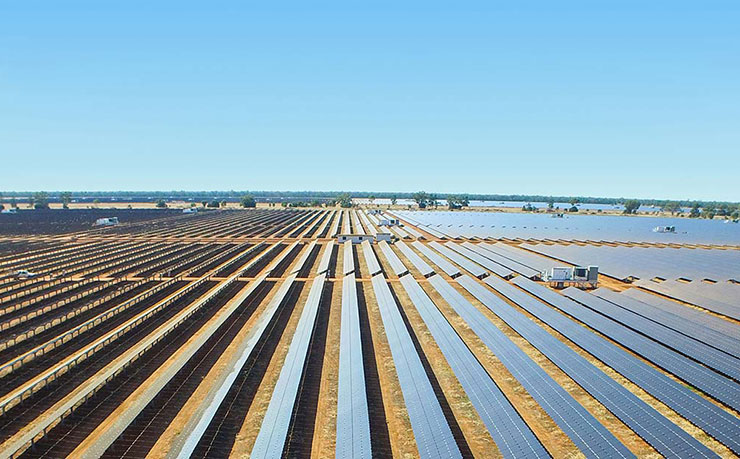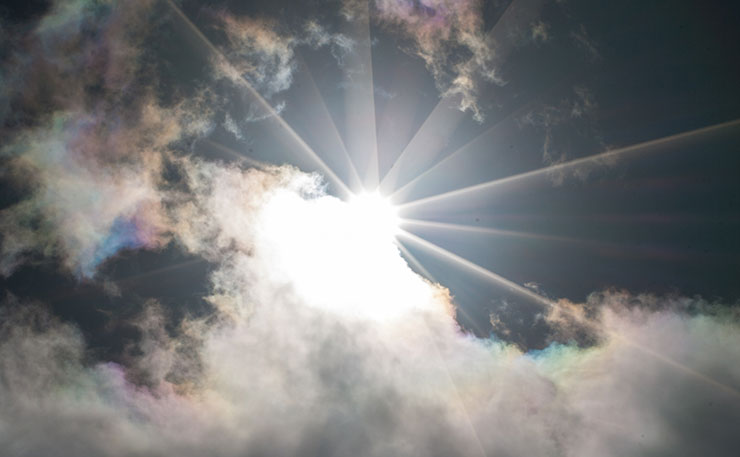Geoff Russell brings you the second of a three-part series on the global renewable energy revolution. The first article in the series looked mostly at the big sources of renewable energy; hydro and biofuel. Part II looks at wind and solar and considers Australia as a special case, and Part III will consider alternatives.
In Part I we noted that one of the planet’s premier ecologists, Bill Laurence, recently co-authored a paper titled: “How green is green energy?”; with lead author Luke Gibson. Part I considered the biggest sources of renewable energy: burning biomass and flooded river valleys. Here’s a summary figure showing the relative proportions of the global supply of renewable energy. Keeping in mind that biofuels are just burning biomass (tree or other plant crops). Increasingly, forests are being logged and turned into pellets to fuel boilers to make electricity.

Now let’s consider some other renewables.
Wind, Solar and Storage
Wind and solar are still currently small in global terms. Which is why advocates never mention absolute size or even relative size, but focus on growth rates. They also never talk about the wildlife impacts.
In Australia, there is little research on such matters, but some figures are coming in from the US. The Gibson paper cites estimates that wind farms are killing 600,000 to 880,000 bats a year, which now makes them the second biggest risk to bats behind White Nose Syndrome. Birds are also getting killed in large numbers, but not large enough to rate next to motor vehicles and transmission lines; unless you are a bird.
But intermittent renewables like wind and solar need a much bigger transmission network than traditional grids, so they will also increase the avian transmission line death and injury toll. How much bigger does the transmission network need to be for wind and solar? 5-10 times. And those 600,000+ bats killed annually in the US are being killed for a power source that generates just 6.3 percent of US electricity.
The Jacobson plan (see Part I or critique here) calls to expand the 82 GW of wind turbine capacity in the US to 2449 GW; so we can expect this to also cost 18 to 26 million dead bats a year. We can also expect the current wind farm toll of half a million birds annually, including 83,000 raptors, to rise by perhaps a factor of 32.
But all these animal and environmental problems wouldn’t be so bad if the technology could both provide a reliable grid while also solving our climate problem… but it can’t.
In Germany, solar power is still only about 6 percent of electricity, but is already stuck.
The following figure shows that solar power growth is levelling off in all the key European countries who spent big on subsidising solar growth. The German data for solar output in 2017 is available and is much the same as for 2016.

Some of this is due to simply running out of money. But the much bigger problem is structural. It doesn’t matter how cheap it is if you can’t sell it. Solar power output in Germany will certainly rise a little more, but it’s unlikely to pass its predicted maximum of about 11 percent of German electricity.
Prediction? What prediction? I don’t know who spotted it first, but this article contains a description of why intermittent renewables will tend to level of at around what’s called the capacity factor… 11 percent for solar power in Germany, and 16 percent for solar power in sunny Australia.
Why? Put briefly, and using wind power, as an example, when you have enough wind turbines to meet 100 percent of the electricity demand on windy days, then the incentive to build more turbines starts to decline. Why? Think about what will happen on windy days after you double the amount of wind power? You’ll simply have to throw half of your electricity out; you can’t sell it.
How much electricity will you get from wind over a year if you satisfy 100 percent of the demand on windy days? This number is called the capacity factor. It’s just the annual average output divided by the theoretical maximum if every day was maximally windy at all turbine locations. It’s about 33 percent, give or take a bit.
So without large amounts of storage, profitability ceases and growth gradually stops, rather like what you can see in the graph.
The largest battery in the world was recently installed with great fanfare in South Australia, but can it store large amounts of energy? No. That was never the intention; as an energy storage device, it’s tiny.
SA typically uses 1,500 megawatt-hours of energy each hour, and the battery could store about 4 minutes worth of this. The battery was never intended to store energy; that’s just a side effect. Its purpose is to reduce frequency fluctuations during generator outages. Not that it will do that particularly well either. ACOLA reckoned it would need to be 6 times bigger to have prevented the September 2016 blackout.
So it won’t store much energy and won’t be much use to stop blackouts; so what’s it for? As a means of securing votes from renewable energy junkies, it’s priceless.
The only available technology which can store significant amounts of electricity to allow renewables to expand beyond their capacity factor is… can you guess? … flooded valleys; otherwise known as pumped-hydro.
So while renewable advocates cheered early exponential growth of solar and wind power, the rates were always destined to be logistic… meaning that they grow exponentially until hit by limiting factors which cause an equally fast levelling off.
If I had included China in the graph, you’d see a massive solar increase during the past few years, because she’s still on the exponential growth segment of the curve. But the limiting factors will eventually kick in, exactly as they have done in the EU countries. In fact, at a local level throwing out excess wind power in China is already a problem.
But what about Australia?
A few years back AEMO did a study on how to meet Australia’s electricity demand with 100 percent renewable sources. They put forward two plans, both involved putting a baseload sub-system underneath wind and solar; one plan was based on burning forests and the other on geonuclear.
Geonuclear is where you drill a hole in the earth’s crust deep enough to tap into the heat generated by radioactive decay in the earth’s mantle and crust. You might know it as geothermal, but it’s a power source based on radioactive decay so why not call a spade a spade? And did I mention the radioactive material being bought to the surface and spread over the landscape by this industry?
Is it a problem? Absolutely not. Meaning that it is a well understood micro-problem which people solve in many similar industries. But could I construct a true but totally misleading scare story about it?
For some people, I probably just did. Not everybody appreciates the irony of opposition to digging big holes to drop radioactive material down (nuclear waste repositories) while supporting digging big holes down to where extraordinary quantities of radioactive material is generating heat.
And what if you don’t want burning forests or geonuclear? A recent study of the US showed what happens when you try and power the US with just wind, solar and storage. It quantifies the lack of end game with these technologies. It’s like trying to build a 10-story building with inadequate materials and design. Things may go brilliantly until level 9 and then you suddenly realise you are screwed.
The US electricity grid is currently about 99.97 reliable, ours is generally even better. The study found that that you can get an 80 per cent reliable grid with wind and solar without too much trouble. And then it starts getting hard; really quickly. By without too much trouble, I mean lots of overbuilding and extra transmission lines.
I’ve pulled out a couple of graphs to explain from the paper.

Look at the bottom graph, which assumes 75 per cent wind and 25 per cent solar. The black line shows how big an overbuild you need if you want a grid of specified reliability. The reliability is given along the X axis and the overbuild factor on the right.
Draw a horizontal line with your eyes from the overbuild factor of 10 and see where it hits the black line. Somewhere about 99.8 percent reliability. So if you want a 99.8 percent reliable supply of 1 gigawatt, then you need to build 7.5 gigawatts of wind and 2.5 gigawatts of solar.
This is very much an optimistic estimate. There are plenty of unrealistic assumptions here, like a perfect transmission system and all your turbines in the best spots. It’s the best you can do; it’s just that the best isn’t really very good.
Now draw a horizontal line with your eyes from the overbuild factor of 5 to the 12 hour storage line. This shows that you can get a 96 per cent reliable supply of 1 gigawatt by building 3.75 GW of wind and 1.25 GW of solar if you have 12 gigwatt-hours of storage.
And in Australia?
You’d have to repeat the study with Australian data to see what happens here, but it’s worth thinking about what 12 hours of storage looks like. In Australia, our average power use is about 28 gigawatts, so to store 12 hours worth of energy would require about 3,100 of those ‘biggest battery in the world’ devices in South Australia. There are plenty of other tiny storage systems that it’s fun to pretend might one day scale to the sizes required, but only flooded valleys have a proven track record.
As it happens, someone has done a very similar study using Australian data. The recently released ACF report A Plan to Repowe Australia lists the study (by Manfred Lenzen of UNSW and others) among its evidence base. It finds pretty much what the US study found; namely that you could power Australia, meaning supply our 28 gigawatts worth of demand) with wind, sun and storage and all you’d need to do is build 160 gigawatts worth of wind and solar farms, including 19 gigawatts worth of biomass burning backup.
A one gigawatt power plant is a large structure, whether it’s burning wood, coal or gas. The 19 biomass burners would be doing nothing for 90 percent of the time, but we’d need them just to plug the holes when there are low wind and sunshine periods. Oh, and they also postulate 15 hours of storage for the 61 gigawatts of solar farms.

How would this be provided? The main paper didn’t say, and I didn’t buy the Supplementary material. But you could do it with about 8,000 “biggest battery in the world” Li-ion batteries. Alternatively you could use fertiliser; otherwise known as molten salt. This is a mix of sodium and potassium nitrate. All you’d need would be about 26 million tonnes, which is over 8 years worth of the entire planet’s annual global production (see here and here); all of which is currently ear marked to grow food.
The South Australian experience
In South Australia, our wind energy supplies us with a little over the capacity factor percentage of energy; which means we are starting to throw away electricity when it’s windy, while relying on gas or coal power from Victoria when it isn’t.
Which is why the new Liberal Government wants to build another inter-connector. That’s fine as a short-term fix, but eventually the whole NEM will saturate with wind and solar. And then where do you build an inter-connector to?
The statewide blackout of 2016 was also a wakeup call that the automatic frequency control delivered by synchronous energy sources but not by wind and solar actually mattered; big time. Without it you are in trouble when events of any kind take out some of your generation capacity.
But ignoring the problems and assuming the US results apply, then we could surely plough on and build another 6.5 times more wind power plus considerably more solar and also buy another 180 of those Elon Musk special batteries and we could have a working, but sub-standard, grid.
This assumes we added all the rest of the required transmission infrastructure to connect all those wind and solar farms. That’s the thing with solar and wind. It may seem attractive when you kick the problems down the road and rave about the short-term successes. But the devil is in the detail and the total lack of end-game.
Next article… is there an alternative to flooded valleys and wood pelleted forests?
Donate To New Matilda
New Matilda is a small, independent media outlet. We survive through reader contributions, and never losing a lawsuit. If you got something from this article, giving something back helps us to continue speaking truth to power. Every little bit counts.




